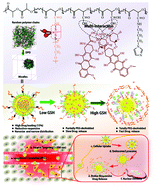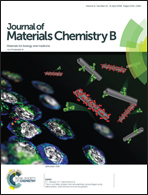Environment-stimulated nanocarriers enabling multi-active sites for high drug encapsulation as an “on demand” drug release system†
Abstract
Limited active sites in polyesters hinder fabrication of multifunctional biodegradable nanocarriers for successful clinical applications. Herein, poly(malic acid) (PMA)-based biodegradable polyesters bearing large carboxyl groups in their side chains were grafted with intracellular reductive-sensitive polyethylene glycol and imidazole to construct bioreducible nanocarriers (PLM-g-ss-EGA). The uniform spherical shape and high stability of the PLM-g-ss-EGA nanocarriers were demonstrated by dynamic light scattering (DLS) and dissipative particle dynamics (DPD) simulations. Enhanced interaction between the monomers in this novel nanocarrier doubled its drug loading efficiency (15%) as compared to that of traditional polyester nanocarriers (5–7%). Moreover, stimulus-responsive assessment and in vitro drug release studies showed that these bioreducible nanocarriers can balance extracellular stability in blood circulation and intracellular “on demand” release. In vitro and in vivo assays have demonstrated that these bioreducible nanocarriers not only can substantially enhance antitumor efficacy as compared to insensitive micelles and even comparably to free DOX·HCl, but can also greatly reduce unwanted side effects in other organs. The encouraging anticancer efficiency of these poly(malic acid)-based nanocarriers opens a new avenue to design multifunctional biodegradable polyester drug-delivery systems.



 Please wait while we load your content...
Please wait while we load your content...